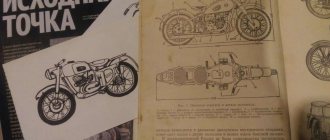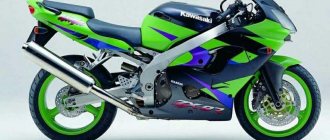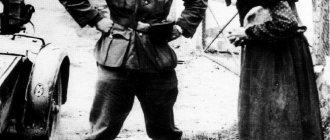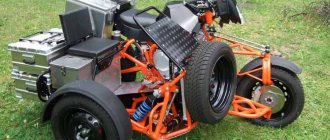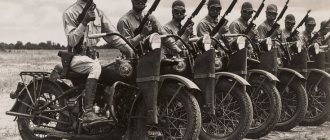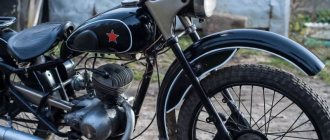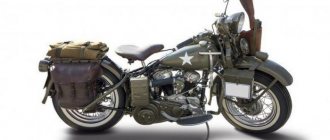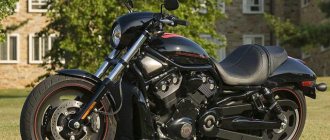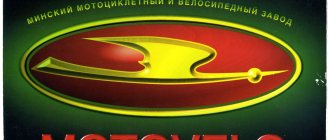Recently, a topic appeared on motorcycle sites to discuss new items in the field of two-wheeled vehicle design. The conceptual model of the presented technique was developed by a group of Chinese students. They presented a crawler motorcycle, which in its design resembled a sports bike. The miracle of technology has a standard suspension, but movement occurs thanks to tracks.
The presented vehicle caused a storm of discussion. Motorcycle enthusiasts immediately had many questions about the driving performance and capabilities of the new motorcycle. Some began to doubt the performance of the presented model. However, it should be said that the development of Chinese designers is not only a conceptual development. History knows real motorcycles on caterpillar tracks. This motorcycle had a number of interesting features.
First developments
A crawler motorcycle is a rather complex structure. Its development was carried out by professional and private designers at the beginning of the last century. The prototype of such a motorcycle was the tracked bicycle, which was developed in 1900 by Henry Steese. He even received a patent for his invention.
Further, in Great Britain in 1927, one of the first motorcycles was created, which had two rear wheels on tracks. It was called RASC Triumph. This vehicle was manufactured by order of the royal army. The model was converted from a similar development with a 2x1 propulsion unit. RASC Triumph received a 3x2 propulsion unit. This motorcycle was made in one copy. When tested, its ride quality was excellent. However, the development was not further developed. Standard motorcycles, which were owned by the royal army at that time, received improved mobility characteristics.
The RASC Triumph is now housed in a museum dedicated to army transport. It is almost impossible to restore the presented vehicle. Museum officials claim that the motorcycle's authentic 11-inch rear tires have been lost.
Video
We present to your attention a video.
On it you will see how a cross-country motorcycle on tracks plows the snow-covered mountain expanses, while performing spectacular jumps and turns. It can be seen that professionals manage this easily, despite the fact that the snow is quite deep. Did you like the article? Tell your friends!
Comments (3)
- Geogriy:
03/06/2015 at 09:38For Siberians who live in the snow for half a year, this is at least an interesting upgrade. The only problem is that from the beginning of this year the rules for registering any vehicle tuning have changed. And so far, as far as I know, registration has been suspended altogether. Therefore, how feasible this is is a big question.
Answer
- Vasily Isaev:
03/08/2015 at 10:46
For a winter type of recreation, this is the best means of transportation, especially since a motorcycle does not consume much fuel; at least a tank of gasoline will last for several days; many fans of all-terrain vehicles will be pleased with this.
Answer
- Vladislav Ukhno:
03/09/2015 at 02:12
Interesting solution. Not new, but already embodied in a high-quality, solid, “factory” form. I also saw such an upgrade in some magazine during the USSR: either Young Technician, or, most likely, Model Designer. I think anyone who wants to keep their steel horse in winter will appreciate such a kit, despite the fact that it is not cheap.
Answer
Motorcycle OES
The crawler motorcycle, developed in Great Britain a year later (in 1928), was manufactured using equipment from the Osborne Engineering Company. At the same time, the company presented two prototypes at once. The motorcycle could be used with or without a track that fit over the wheels of the rear bogie.
The rear second wheel of the presented developments was connected to the first wheel by a toothed belt. Such motorcycles were created for the army and private use. They were used like tractors. However, the new equipment did not arouse much interest among buyers.
Similar developments were carried out in Italy. The model, released in 1931, was called a tractor cycle. Initially it was developed for agricultural needs. However, over time, fascist policemen in Italy began to exploit it. Initially, the developers of the “tractor-motorcycle” planned to use it for economic purposes.
Road situation in winter
In winter and late autumn, public roads become completely unpleasant and unsuitable for driving without the protection of a car body. Even in summer, driving along them is far from a gift. Add to this the fountains of mud and reagent that flow from under the wheels of each car, and in which any participant in the movement will bathe, and you will get the real picture. In addition, do not forget about sleet and frost. Both the motorcyclist and the other driver can make a mistake. Only where the motorcyclist breaks his neck will the driver of a four-wheeled vehicle simply slide slightly into the next lane. Accordingly, if it does not hit other vehicles, then there will be no problems.
More pleasant situation on country roads. If the road is well-trodden, almost any motorcycle can easily pass along it. It's even nice. However, you still shouldn’t expect full movement.
Fans of motocross and other extreme disciplines have a much more pleasant picture. Those who use a motorcycle as a sports equipment, on the contrary, can get a lot of pleasure from riding on a snowy track! It is much more varied and requires more control over the motorcycle, and therefore much more interesting.
Accordingly, of all the options, the road situation allows you to use a motorcycle more or less comfortably only for sporting purposes and for quiet driving outside the city. It is very pleasant and interesting to ride in the snow. Driving on public roads in winter will be at least uncomfortable, and sometimes even dangerous.
The first German motorcycles
The German caterpillar motorcycle was needed for military purposes by the country's government. Therefore, the development of new vehicles here was carried out quickly and on a large scale.
One of the first tracked motorcycles was the Victoria model. It was introduced to the general public in 1931. This transport place was designed for 3 seats with a 3x2 propulsion unit.
The presented model was created over 4 years (from 1927 to 1931). It could reach speeds of up to 120 km/h. The engine on this motorcycle was four-stroke with a volume of 596 cm³. The rpm power was 18 hp. With. A sports model was also developed. It had a rpm power of 24 hp. With. At that time it was a high-quality motorcycle that became quite widespread among consumers.
Major snow kit manufacturers
Two Russian ones - SNOWRIDER - Tyumen, VORTEX - Perm.
Two American ones - TIMBERSLED, YETI.
Fundamentally the circuit diagrams of the kits are the same. Three sizes of track lengths - from 120 cm to 137 cm. In terms of weight, American kits are slightly lighter than Russian ones. A kit from any manufacturer weighs about 60 kg. The price varies from 290 to 400 thousand rubles. Despite the high price, snow kits are in demand. And they are selected in accordance with the power of the motorcycle - the longer the track, the larger the engine displacement should be.
BMW Schneekrad motorcycle
The army needed full technical equipment. Therefore, funding was allocated for the creation of new models of equipment, vehicles and weapons. The most famous Wehrmacht tracked motorcycle was created on the basis of the BMW R12. The new model is called the BMW Speziel TR500 Schneekrad. It was presented to the general public in 1936 in one copy.
To date, not a single copy of the presented equipment has survived. This motorcycle had a sidecar that was mounted on a ski. Its chassis was taken from a light tank. It fit completely inside the caterpillar.
The controllability of this vehicle was poor. It was extremely difficult to make turns. The motorcycle reached speeds of up to 125 km/h. 20 thousand copies were created for civilians, and 10 thousand units of equipment for the military. Moreover, the speed of motorcycles with Wehrmacht caterpillars was less than that of civilians (only up to 85 km/h). This model has become a classic, but is not widely used.
Iron horse: how motorcycles were used in military operations
Since the domestication of the horse and the invention of the wheel, man has used every possible means of transportation for military purposes. Chariots, carts, cars. This fate did not spare the motorcycle either. We decided to understand the evolution of military motorcycles from the first models from the beginning of the 20th century to the present day
The first military “motorcycle” is considered to be the Motor Scout, introduced in 1898 by Frederick Sims. The lead in this case went to the British brainchild controversially, since Sims’ invention had four wheels, but in all other respects it was a motorcycle. Based on a bicycle frame and saddle, Sims' Motor Scout was equipped with a 1.5-horsepower engine from the French company De Dion-Bouton, a Maxim machine gun and an armored shield that protected the shooter's chest and head. In addition to the driver-gunner, the Motor Scout could carry 450 kilograms of equipment and fuel, which was enough for him to travel 120 miles. Unfortunately, due to the end of the Boer War, Frederick Sim's invention was not widely used in the army.
MOTOR SCOUT
First World War By the beginning of the First World War, the idea of introducing motorcycles into the army had finally taken root in the minds of military leaders in all progressive countries. The main reason for this was the completely rational idea to replace horses with motorized equipment. It was thanks to this that couriers and messenger soldiers were the first to receive motorcycles in the army, but many armies did not limit themselves to using them only in this way. The first motorcycles, reinforced with machine guns, appeared in the German army. Unlike Sims's invention, these were modernized civilian motorcycles that were not well armored. It is worth noting that attempts to create an armored motorcycle continued until the fifties of the 20th century, but did not lead to anything. Despite this drawback, German “mobile machine gun emplacements” were successfully used in some operations on the fronts of the First World War.
The next step in the development of military motor vehicles was the quite logical appearance of mobile air defense systems. Aviation has ceased to be used only for reconnaissance and has begun to be used on an equal basis with other equipment in combat operations. In this regard, there was a need to repel attacks from the air, for which large-caliber machine guns were installed on motorcycles.
Unfortunately, throughout the First World War, the motorcycle rarely saw action on the battlefield. His main occupation was transportation of the wounded, courier service and prompt delivery of various goods, including fuel for other equipment.
During World War I, motorcycles rarely took to the battlefield. His main occupation was transportation of the wounded, courier service and prompt delivery of various goods.
Post-war fever
After the end of the First World War, all participating countries, having appreciated all the advantages of motorcycles on the battlefield, began to develop new types of motorcycles. Many of them were too futuristic for their time. For example, in 1928 the French introduced the new Mercier motorcycle. Its main difference from other colleagues in the workshop was the front caterpillar wheel, which for that time seemed to be a very fresh idea. Later, in 1938, also a Frenchman, engineer Leître, introduced his motorcycle called Tractorcycle. As the name suggests, Leêtre modernized the 1928 model by making his motorcycle entirely crawler-mounted. It would seem that light armor and high cross-country ability should have made this model an ideal military motorcycle, but there were a number of serious shortcomings: heavy weight (400 kilograms), low speed (with a 500 cubic centimeter engine it reached a speed of only 30 km/h) and poor handling. Since the motorcycle was turned by bending the track, the motorcycle was extremely unstable when turning. Leêtre later added side wheels to his design, but the army was never interested in his development.
A non-standard model of a military motorcycle was also created in Italy. Guzzi designers presented a tricycle equipped with a machine gun and the same armored shield, but the distinctive feature of this motorcycle was that the machine gun was pointed backwards and there was no way to deploy it.
Belgium also tried to create something original, and in 1935 the FN concern succeeded. Belgian designers presented a simpler model of the M86 armored motorcycle. Compared to other European “colleagues,” the M86 turned out to be successful: the motorcycle was equipped with a forced 600 cubic centimeter engine, a reinforced frame, and armor plates that covered the motorcycle and the driver on the sides and front. The M86 could also carry a fully armored sidecar, on which a Browning machine gun was mounted. During the entire production period, about 100 similar motorcycles were produced, which were in service with countries such as Romania, Bolivia, China, Venezuela and Brazil. Unfortunately, not a single copy has survived.
In addition to various ideas that were poorly suited for life, the “ordinary” motorcycle industry also developed. This was especially noticeable in Germany. After the end of the First World War, under the terms of the peace treaty, Germany was prohibited from producing all types of weapons, but there was not a word about motor vehicles. In this regard, the real dawn of motorcycle construction began in Germany. The main factor for the development of this area was that a motorcycle could be purchased by the average resident of a devastated country, while a car remained the preserve of the rich. This is what prompted BMW to switch from producing spare parts for trains to motorcycles and enter into competition with the second major motorcycle manufacturer in Germany, Zundapp.
At first, BMW did not introduce anything new, installing the M2 B15 boxer engine on their motorcycles, which actually copied the English Douglas engine, but by 1924, engineers presented the first production motorcycle, the BMW R32, created from scratch.
But time passed, and from the beginning of the 1930s, the Bavarian concern realized the need to create a specialized military motorcycle. This is exactly what the BMW R35 became. Unlike its predecessors, it had a telescopic front fork and a more powerful engine with a capacity of 400 cc. An important point for the army was the cardan drive, which was distinguished by its high wear resistance relative to the chain drive. Of course, the R35 also had “old sores”, for example, a rigid rear suspension. Sometimes the frame would burst under heavy loads, but this did not prevent the R35 from getting into service. This motorcycle was successful both in the infantry, motorized units and medical battalions, and in the police. Production of the BMWR35 continued until 1940, after which it gave way to highly specialized military motorcycles.
BELGIAN FN M86
GERMAN BMW R32
BMW R35
At the same time as the R35, BMW released the R12. In fact, it was an improved version of the R32. The motorcycle had a 745 cc engine and telescopic forks with hydraulic shock absorbers, which made it a class higher than the R35. When creating the military version of the R12, one of the two carburetors was removed from the design, which reduced power from 20 horsepower to 18. Thanks to its low price and good performance, the R12 model became the most popular motorcycle in the German army. From 1924 to 1935, 36,000 of these motorcycles were produced. Like most BMW motorcycles, the R12 was produced both “solo” and with a sidecar. When it was produced, it was curious in that it did not have a single weld and had a specially designed spring for careful transportation of the wounded.
The last, but no less interesting motorcycle in the pre-war BMW line was the R71 model. Produced since 1938 in four modifications, it was the founder of Soviet military motorcycle production.
In addition to BMW, the aforementioned Zundarr motorcycle concern also took part in the industrial race, which also carried out government orders. Zundarp supplied three main models: K500, KS600 and K800. The K800 model with a sidecar was very popular among soldiers. Due to their low cost, they easily found their way into service, but of the entire line presented by Zundapp, only the K800 could compete with the BMW R12. The K800 was also interesting because it was the only four-cylinder model in service in the German army. This feature was partly a disadvantage, since the rear cylinders of the K800 were poorly cooled, which led to frequent oiling of the spark plugs.
In Russia, during and after the end of the First World War, there was practically no motorcycle production of its own. This continued until the 1930s. It was then, at the time of the technical re-equipment of the Red Army, that the need arose for their own motorcycle, which could withstand all the hardships of the Russian weather. The first domestic motorcycles specially developed for the army were the L300 and KhMZ 350. In fact, the KhMZ 350 was a copy of the American Harley-Davidson, but the Russian analogue was much inferior in quality to the Western motorcycle, and it was decided to abandon it. It was replaced by the TIZ-AM600, produced since 1931. This motorcycle was developed and supplied only to the army. Being a combination of Harley and some British influences, the TIZ-AM600 was the domestic car industry’s own development, although not particularly outstanding.
In 1938, domestic design bureaus presented several models at once: Izh-8, Izh-9 and L-8. The most striking and successful among the presented motorcycles was the L-8. The relatively powerful overhead valve engine of 350 cubic centimeters was the pride of the domestic motorcycle industry. But despite the fact that the L-8 model was produced at several factories throughout Russia, the motorcycle did not meet all the needs of the army. This was due to the fact that each plant made its own amendments to the motorcycle design, which led to a lack of unification in spare parts and turned into a serious problem in combat conditions.
GERMAN ZUNDAPP K800
SOVIET TIZ-AM600
SOVIET L-8
The Second World War
Kraftrad (“power wheel”) is what the German army called motorcycles. This is where the abbreviation “Krad” or the letters “K” and “R” came from in the designation of some motorcycles. But first things first.
Since 1940, real reforms began in the German army. Despite the success of almost all pre-war BMW and Zundarp models, the command demanded a completely new class from manufacturers: heavy motorcycles. The first and only of their kind were two motorcycles: the BMW R75 and the Zundapp KS750. These were “draft horses” specially designed for off-road travel. Equipped with sidecar wheel drive and special off-road speed, both motorcycles have proven themselves extremely well. However, due to the high price, these motorcycles were supplied first to the Afrika Korps and parachute units, and after 1942 to the SS troops. Also in 1942, it was decided to produce a new, improved Zundapp KS750 motorcycle with a BMW 286/1 sidecar, but, unfortunately, this model never saw the light of day. Its production was supposed to begin after fulfilling an order for the production of 40 thousand R75 and KS750, of which only about 17 thousand were produced during the entire war.
The Sd half-track motorcycle became something completely new for the German army. Kfz. 2, known as Kettenkrad. Produced from 1940 to 1945, the Kettenkrad was designed to transport light guns and was more of a tractor than a motorcycle. Inside this model there was a one and a half liter Opel engine. In total, during the war years, 8,733 such units were produced, which were mainly supplied to the eastern front. Tracked traction coped well with Russian off-road conditions, but they also had their drawbacks. The Kettenkrad often flipped over on sharp turns, and due to the landing system, the driver was unable to quickly jump off the motorcycle. Also on Sd. Kfz. 2 it was impossible to drive diagonally onto hills.
Despite the success of almost all pre-war BMW and Zundarp models, the command demanded a completely new class from manufacturers: heavy motorcycles.
There is a legend about the appearance of a full-fledged motorcycle in the Russian army: When in 1940, all the latest motor developments of almost all countries were presented to the Committee on Armored Forces, one of the high-ranking military officials asked: “What are the Germans attacking?” In response, they pointed to the BMW R71. From that moment on, the development of the M72 motorcycle began. The first batch of these motorcycles came off the assembly line in July 1941, after the invasion of German troops into the territory of the USSR. The M72 was virtually no different from the R71: it had a simple design, an opposed lower valve engine, providing a low center of gravity, with a power of 22 hp. s., a duplex tubular frame using variable-section pipes, a front fork with hydraulic shock absorbers, a cardan drive for the rear wheel and power for each cylinder from an independent carburetor. Of course, the motorcycle was not fast (the maximum speed of the M72 is 90 km/h), but it had high torque, which was a big advantage for a military vehicle.
The BMW R71 also impressed American designers. Thus, the American production “planted” the two-cylinder R71 engine with a four-speed gearbox and drive shaft drive to the rear wheel on the classic basis of the Harley-Davidson company, thus obtaining the new Harley-Davidson 42XA motorcycle. This motorcycle was mainly used in North Africa. At the same time, the Harley-Davidson WLA42 also entered the production line. The WLA42 military motorcycle was a descendant of the civilian Harley-Davidson WL and differed from its “peaceful brother” only in reinforced fenders, an air filter with an oil bath and other crankcase breathers that prevented dirt from getting inside the engine. It was also equipped with a trunk, leather cases and a holster for a Thompson M1A1 assault rifle. Inside, the motorcycle had a V-shaped two-cylinder engine of 740 cubic centimeters, which allowed it to reach an impressive speed of 110 km/h for that time.
The WLA42 was also supplied to the Soviet army, where it was often equipped with a stroller from domestic models. However, the Americans also supplied other motorcycles to the Allied armies, such as Indian, Model 741 Military Scott and Harley-Davidson WLA45.
The WLA42 military motorcycle was a descendant of the civilian Harley-Davidson WL. It differed from its “peaceful brother” in having reinforced fenders, an oil-bath air filter and other crankcase breathers that prevented dirt from getting inside the engine.
Army motorcycles after the war After the end of World War II and the final division of Germany between the allied countries, the BMW R35, produced by the Germans from 1935 to the 1940s, again entered the arena. In the Soviet occupation zone, production of the R35 resumed in the city of Eisenach in 1946. Of course, the motorcycle has been modified and modified. It changed the electrical equipment and power system, and also added a rear suspension. This is exactly how he began to act in the USSR. Powerful and unpretentious, it was in great demand. Much the same thing happened with the rest of the World War II motorcycles. They were redrawn and changed, but the essence remained the same.
A serious novelty was the Ural IMZ-8.107, shown in 1995, which is still in great demand. Equipped with a Gear-Up sidecar, this motorcycle is a derated version of the civilian IMZ-8.017. This motorcycle can be equipped with a machine gun, making it an excellent piece of military motorcycle production.
Also now popular is the military Harley-Davidson with a two-stroke single-cylinder Rotax engine of 350 cubic centimeters. This model is widely distributed throughout the world and is used as a reconnaissance or escort motorcycle. However, like most modern military motorcycles, the Harley has a drawback: it uses JP-8 fuel. The composition of JP-8 is more like a mixture of aviation kerosene and diesel fuel, which makes it unsuitable for use with conventional gasoline engines. But there are also exceptions. For example, the HDT M103M1 motorcycle, created on the basis of the famous Kawasaki KLR650, uses simple diesel fuel, which is an undeniable advantage. This motorcycle also boasts high efficiency. At an average speed of 55 mph, it travels 96 miles per gallon of fuel.
"URAL" IMZ-8.107
All-terrain motorcycle NSU Kettenkrad HK 101
The first German tracked motorcycle to go into mass production was more like a small tank. This model was released in 1944 and was called NSU Kettenkrad HK 101.
This all-terrain vehicle is called a motorcycle due to the appropriate driving position and the presence of a front wheel. Braking is performed using track clutches. One turn is enough for this.
In the post-war years, the presented technology was used by the German Forestry Commission for its own purposes. Today the cars presented are still preserved. The restored equipment was even sold at auction in 2015. It has a completely restored transmission, differential, engine and final drive.
Photo gallery
Off-road motorcycles – motocross and sport-enduro – are vehicles for year-round use. They, unlike other two-wheeled brothers, do not hibernate. In this collection you will find photos of motorcycles of various models with tracks installed on them.
Motorcycle snowmobile
The crawler motorcycle was constantly improved. In 1980, the Italian company Pozzo di Recoaro created a new type of equipment called the Alpen Scooter. This motorcycle was more of a snowmobile. Initially, it was used for its own purposes by the Italian army to move through snow-covered mountains.
The motorcycle included a front ski. To move on soil and ice, a certain type of caterpillar was used. Early models used a 200 cm3 engine, then it was changed to a 250 and 300 cm3 engine. The presented equipment was also used to transport medical workers to patients in snowy weather.
Mototrack in Motocoach.PRO
As already mentioned, we tested a motorized track from the Canadian company Explorer installed on a BMW G450X motorcycle. It makes no sense to install such a kit on smaller motorcycles, since there simply won’t be enough traction. The immediately obvious option with a 300 cc two-stroke is probably more adequate, but has its negative sides - too high gas consumption.
Since the motorized track is actually half of a snowmobile, the first question that haunted me was: how to set it up in the snow when the footrest fails? But it turned out that in loose snow this structure sticks out like a spoon in good sour cream - there were no problems with leaving the motorcycle and moving somewhere to the side.
Despite the fact that the height of this track set is comparable to regular 21 by 18 wheels, the bike with the Explorer seemed higher in the saddle to me. And if you consider that when you sit on a motorcycle in the snow, your legs sink, for short people riding such a thing can be problematic. Offhand, the lower height limit for a motorcyclist to ride comfortably on a motorized track should be about 175 cm. I was absolutely comfortable with my 183 cm.
Now a little about management. Structurally, the Explorer ski has runners that allow you to “cut” on shallow packed snow. An analogy can probably only be drawn here with a snowboard. Turning on a motorized track is carried out only with the help of weight, and a comfortable ride is achieved only in the rear pillar. The design hardly steers even while moving, and this is what gives such a lot of new sensations. However, if you have the habit, you can even drift!
In deep snow, the Explorer suddenly begins to steer perfectly and turns predictably - the main thing is not to let off the gas!
But jumping on a motorized track is almost impossible. Not only is the structure quite heavy, but the track itself is rigidly attached to the swingarm and frame of the motorcycle. Because of this, the sensations from small jumps are very peculiar. The landing is hard, and overall there is a feeling of clumsiness.
After a test drive of the motorized track, I was left with a feeling of insufficient traction. If you are not used to it, it is not always possible to select gears, and you have to play along with the clutch. But usually the larger the cubic capacity, the greater the weight. However, in my humble opinion, the ideal track bike option is some 500cc KTM EXC, as a compromise between the stupidity of the engine and the overall weight of the structure.
The bottom line: 1. As a winter attraction for motorcyclists - just great! I especially recommend it after snowfalls, when powder appears! 2. As an affordable test drive before purchasing such a set for your motorcycle, to use somewhere in the country or when traveling into the wild nature of some Karelia, it also makes sense. Just so as not to buy a pig in a poke. 3. If after a test drive you feel a lack of skills in driving a motorized track, in the same Motocoach.PRO there is a chance to immediately improve these skills. Because an experienced trainer is “included in the price” of the test drive.
Homemade modifications
Motorcycles with crawler tracks had a number of disadvantages. It was problematic to stabilize them in a vertical position at high and low speeds, as well as when moving over rough terrain. Therefore, private users have always been skeptical about such technology.
However, in the 60s of the last century, homemade tracked motorcycles appeared. Their designers created similar equipment from scrap parts. Such motorcycles were used for driving in snow and for agricultural purposes.
One of the first and most famous motorcycles of this type was the ANT-1. Its prototype was the models of Soviet snowmobiles, which at that time were presented on the pages of the “Modelist-Constructor” magazine. Karelian engineer A. Koksharov developed several models of the ANT tracked motorcycle. This technique was capable of driving through snow up to 25 cm deep. The weight was 110 kg.
Why SNOWRIDER SNOWBIKS
, Snowrider PRO snowbike kits change due to the introduction of the latest materials and technologies into production. the 2019 season with a colossal list of improvements and innovations:
- The weight of the longest set, SR 137 PRO, has been reduced to 55 kg. This is significantly lighter than the shortest 120 kit of the previous generation. This was achieved through a whole range of innovations.
- The 2021 model range is based on a new platform with a spar-type . Material: aviation alloy steel .
- Effective braking in any operating conditions is ensured by a brake system with a fixed-type two-piston caliper .
- The brake disc and caliper are reliably protected from contact with snow, which prevents them from freezing !
- Kits are now supplied with the brake caliper attached and bled , making kit installation even easier and faster.
- The upper part of the tunnel is made of polymer material that can withstand ultra-low temperatures . This affects the strength and lightness of the entire structure and eliminates resonant noise during movement.
- The weight of the suspension was reduced by 10% . This was done due to the new design of the skids and the replacement of the material of the suspension arms with high-strength alloy steel.
- The suspension kinematics have been redesigned, its travel has increased by 30% , and operation has become even more comfortable and predictable.
- The 2021 track kits come with a one-piece, fully milled I-beam skid made from hardened aluminum alloy. The strip has a modern lightweight design and high quality workmanship.
- The drive shaft has become smaller in diameter and moved even higher. The gears have become longer and more comfortable to drive.
- The bypass star in the gearbox was replaced with a slider , which reduced the noise level and increased the reliability of the unit.
- All kits come with the proven MOTO65 tracks from Composit Tracks . For the new season, the stiffness of the track has been increased by 5 units (Shore).
- The middle keel of the ski received an updated double metal skate . Now, when driving on packed, dense snow, braking is not felt. Thanks to the optimized profile, the skate copes well with obstacles in the form of stones, asphalt roads and even just open areas of land.
- High carbon steel side skates with deep hardening provide precise and easy control.
- As of 2019, SNOWRIDER track kits boast an optional Surface Control System for the ski , which affects the behavior of the snowbike on all types of surfaces. It clearly maintains its trajectory during aggressive maneuvers in deep snow and on a compacted surface, allowing the snowbike to easily “float” in deep snow when climbing a steep mountain or vice versa, when descending steeply. The system allows you to maintain speed when attacking steep slopes, going up and down, which in turn increases the maneuverability of your motorcycle.
Motorcycle "Ural"
There are models of the presented equipment, which are now assembled from various mopeds. For the population of our country, domestically produced vehicles are more accessible. Therefore, it is not surprising that, for example, the Ural tracked motorcycle could appear.
Amateur engineers modify the design of their vehicle for various purposes. This makes it easy to move through the snow and transport fairly large loads.
When creating such a miracle of technology, parts from a combine harvester are used, as well as a motor from a Ural motorcycle. The movement of such equipment is quite maneuverable. At the same time, fuel consumption is about 6 liters per 100 km. The equipment reaches speeds on virgin soil of up to 60 km/h.
Physical Features
When designing such a vehicle, you need to remember several important laws of physics, without knowledge of which your work will be reduced to zero. For good cross-country ability on a snowy surface, you need to make the contact area with the coating as large as possible. This will help the snowmobile not to fall through. In order to reduce the load on the snow cover, you need to make the weight of your vehicle as small as possible. In order for your snowmobile to be stable, another law of physics should be applied - you need to make at least three points of support. That is, a snowmobile with three skis will be more stable when moving than with two. The design may consist not only of skis, but, for example, of one track and two skis or, conversely, of a ski and a pair of tracks. There can be four support points, then you will get something resembling an ATV.
Most often, such units as “Dnepr”, “Izh” are used for such conversion; you can also find a “Ural” motorcycle on tracks. The steering part is left original; all the necessary systems are connected to it - clutch, gas lever. Steel pipes or angles are used for the frame. To make the ski, sheet steel and again angles are used.
The principle of making homemade equipment
Many amateur engineers are trying to make a caterpillar motorcycle with their own hands. This is a tempting idea, which rather falls into the category of constructive delights. Such a vehicle will allow you to move on sticky surfaces, such as snow, mud or wetlands.
The movement speed of such homemade products is quite low. Therefore, the presented technique is not very effective. Today there are special sets on sale. They are purchased by amateur designers to create their own models of tracked motorcycles. This is a complex process. It allows you to create an all-terrain vehicle or snowmobile based on a finished motorcycle. Typically the track is mounted on the rear wheel. In this case, the weight will be distributed incorrectly. If the track is not properly loaded, it will not be able to do its job.
Features of design and operation
It’s worth starting the analysis with the caterpillar, it has interesting features:
- Due to the design of the trolley, the caterpillar does not lose traction with the snow - the elastic design promotes constant contact with the surface;
- There is a slight curvature visible in the track frame. This design feature allows you to change the contact area depending on the surface.
- The length of the caterpillar is smaller than the wheel, but the width is about 25 centimeters, which provides increased stability.
The ski that replaces the front wheel only at first glance seems like an ordinary piece of plastic. In fact, it is a functional and durable suspension element .
The ski allows you to deflect the front part by 6 °, but at the same time contact with the surface is not broken.
Another feature is the presence of lateral incisors that bite into the snow . In addition to turns, the tip of the ski can be lowered and raised.
Thanks to these actions, you can cope with any snow conditions.
For example, when overcoming soft snowdrifts, you should lift the ski , then it will not bury itself, and the motorcycle will glide without braking.
In the case of hard surfaces, you need to do the opposite - a lowered toe will provide excellent glide.
Disadvantages of homemade designs
It is quite difficult to create a tracked motorcycle with your own hands at home. First of all, you will need to do a lot of welding work. Most often, an amateur engineer will not be able to solve the problem of proper weight distribution of equipment. In this case, he may try to move the track forward. However, this task is usually practically impossible to accomplish at home.
Therefore, engineers can make compromises. Two small caterpillar tracks are placed on the sides. They are shifted forward to a lesser extent by a maximum of a third of the length. Such a caterpillar will be able to perform its functions fully, but only on a flat road.
Therefore, many technologists argue that creating a tracked motorcycle is not a practical necessity. Rather, it's just a design puzzle. Although today many worthy pieces of technology have been developed. They take into account the local conditions. The process of creating such equipment brings amateurs many positive emotions. This is a real challenge for any designer.
All in your hands!
We see that you can convert any motorcycle or walk-behind tractor, put it on tracks, skis, or combine it. Fantasy is not limited by anything except its own capabilities. First, look around your garage - maybe you already have a caterpillar for a motorcycle in stock. If so, you can begin assembly. Even if you are using a track for a motocross motorcycle, do not forget about safety, which should come first. You need to think not only about yourself, but also about those around you who you may harm. Take a test drive in a deserted area. Was the test drive a success? Now we're off to the track!
There are a huge number of options, all of them unique in their own way. They can safely be classified as handmade, because almost every detail is made individually. The choice of materials and manufacturing methods is also huge. In addition to a standard set of plumbing tools, you will definitely need a welding machine, possibly a pipe bender, an angle grinder, etc. But one thing is clear: making a track for a motorcycle and turning it into a snowmobile yourself is much more interesting, and most importantly, cheaper than simply purchasing ready-made components.
DKW - Dampf Kraft Wagen
The Germans came up with their own abbreviation for the motorcycles of this company - Des Knaben Wunsch or, Das Kleine Wunder, which translates as “boys’ dream” and “little miracle”.
Small and nimble motorcycles in the ranks of the German army, with modest dimensions and small engine volumes, became very popular outside the front for their size and efficiency.
RT125
NZ350
The overall result: the consequences of the First World War laid fertile ground in Germany for the successful development of the motorcycle industry and a whole niche of this type of transport. By the beginning of the Second World War and at the height of the conflict, the motorcycle industry had entered a new stage of development, improving the cross-country ability, endurance of equipment and repairability in conditions, as they say - on their knees.
